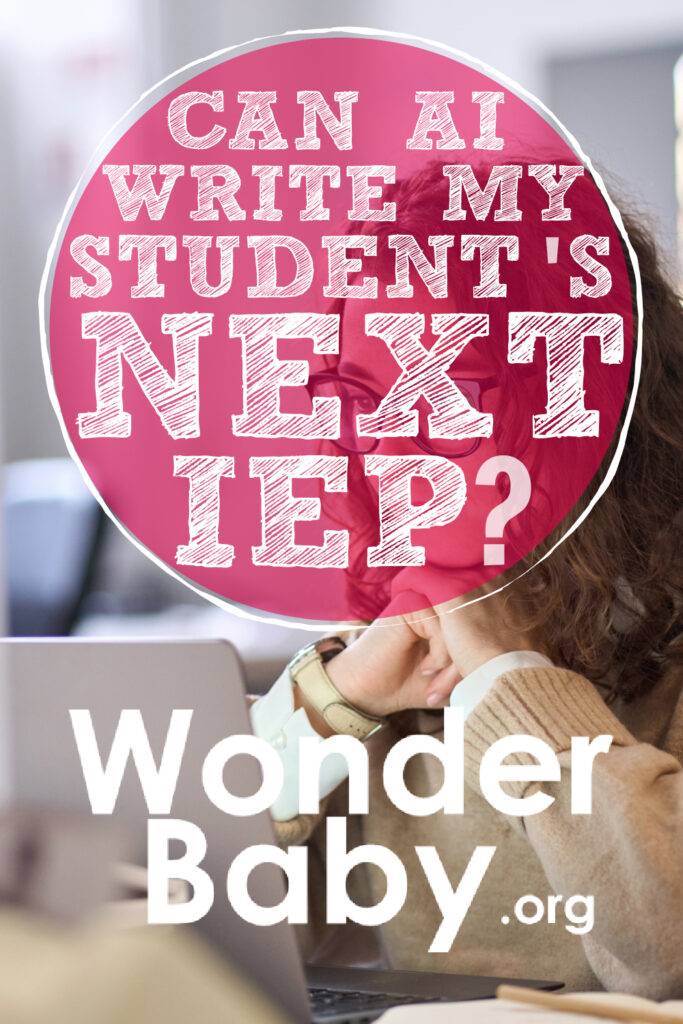Can AI Write My Student’s Next IEP?

- Special education teachers can use AI when writing an IEP, but it’s important to acknowledge it may not be error-free.
- AI can help save precious time for special education teachers while creating reports and recommendations.
- AI tools are helpful but shouldn’t replace humans when writing student IEPs.
Technology is terrific, but we likely agree that it shouldn’t replace the teachers in our children’s classrooms. Creating individualized education programs (IEPs) is necessary for students when using special education services, and AI is stepping up to help.
Artificial intelligence has proved its worth in certain areas, but can AI write an IEP? While it has benefits, it’s essential to understand the pros and cons of using artificial intelligence when creating a student’s IEP.
As a teacher, you have a lot on your plate. A LOT! AI has the potential to allow you more time one-on-one with your students while spending less time on paperwork, but is it for you?
Pros of Using AI in IEP Development

Special education teachers understand the amount of paperwork associated with IEPs to ensure compliance with the Individuals with Disabilities Education Act (IDEA). Creating multiple student plans can be time-consuming, but AI can help streamline the process.
There are pros to consider when creating IEP strategies and goals, including writing lesson plans and increased efficiency when working with students.
Additional benefits of using AI to assist in IEP writing for a student include:
- Ability to analyze vast amounts of data to personalize education further
- Create strategies for special education teachers to write an IEP
- Focus more on the student than the paperwork
- Provides consistency and compliance with local regulations
- Better understand social anxiety in special needs kids
- Help focus on early intervention and detect early warning signs of challenges
- Enhance accessibility by providing support for communication and learning challenges
Continually documenting essential information regarding a student’s IEP goals is important, ensuring you identify the individual’s specific needs throughout the process.
Cons and Limitations

While AI can help create IEPs, it doesn’t always guarantee accuracy. Special education teachers and administrators should remember to review any information produced by AI tools before proceeding with a plan.
For example, AI may create unwanted biases11. Artificial Intelligence and the Future of Teaching and Learning. Office of the Educational Technology. 2023. https://www2.ed.gov/documents/ai-report/ai-report.pdf and miss out on teachable moments that a teacher would address but are undetected by AI.
In addition, you shouldn’t input personal information into the AI generator to prevent sharing confidential information. While it doesn’t eliminate the possibility of privacy concerns, you can use fake names while using AI tools to protect your students’ identities.
Examples of cons of using AI to develop IEP lesson plans include the following:
- Lack of emotional intelligence
- Understanding of nuanced human needs
- Ethical concerns
- Limitation of details
- Over-reliance on technology
Finally, remember that machines can never replicate educators’ experience, empathy, and expertise. While the process can help streamline your paperwork, it shouldn’t take over your job as a teacher.
Integrating AI into the IEP Process

Special education teachers play a vital role in integrating AI into the IEP process, as it can be a valuable tool for supporting students with unique needs. It’s recommended for schools to teach their staff how to properly use AI, avoiding errors and allowing for a learning curve.
Collaborative Models for AI and Human Interaction
When creating better IEPs, it is essential to view AI as a passenger, not a driver. Parents and teachers shouldn’t use AI to replace human capabilities entirely; instead, they should use it to provide insight, data results, and automated routine tasks.
AI can help parents and educators with the following:
- Write personalized learning plans
- Monitor progress and provide feedback
- Analyze student data to create an IEP goal
- Identify patterns and trends
- Document behavioral or emotional challenges
Preparing for an AI-Assisted Future
Artificial intelligence is making its way into our worlds, and educating yourself is one of the best ways to be prepared. Parents and special education teachers can learn strategies for effectively using AI tools when creating an IEP plan.
In addition, it’s important to advocate for ethical AI use in education, particularly while teaching in the classroom and creating IEP goals.
Here are some considerations for teachers while preparing for an AI-assisted future at school:
- Explore AI-powered tools while gaining an understanding of the learning systems.
- Participate in professional development opportunities focused on AI, like webinars, workshops, or conferences.
- Adopt a growth mindset and be open to experimenting with new technologies.
- Prioritize ethical considerations, ensuring practices are fair and transparent.
When educators take proactive steps, they can better prepare themselves for effectively using AI in their classrooms, leveraging its potential while enhancing their students’ learning and teaching experiences.
IEP Goals Prompt Examples

You can type in a prompt into AI for a student and receive an IEP goal. For example, if I type in “Develop a measurable goal for a student with a reading disability,” I receive the following response:
By the end of the semester, when given a grade-level text, the student will accurately decode and comprehend at least 80% of the words independently, as demonstrated by teacher-recorded observations and progress monitoring assessments.
You can make the goal prompt more specific by adding the student’s grade level and the length of time you’d like them to work on a particular task.
You’ll likely notice the longer you work with AI to create students’ IEPs, the more comfortable you are with the program.
AI Prompting Strategies

Several prompting strategies exist to ensure the best possible outcome when using AI services for writing, including:
- Use AI to adjust students’ goals once they hit specific milestones, ensuring they continuously learn and grow.
- Ask AI to provide constructive feedback on students’ responses to prompts while helping guide them toward the correct answer.
- Use AI to generate personalized prompts based on preferences, goals, and individualized learning profiles.
- Combine various AI-generated prompts, including written, auditory, and visual, to accommodate diverse preferences and sensory needs.
When you incorporate these AI prompting strategies into educational settings, you can better support the development and learning of special needs students, leading to greater inclusivity and academic success.
FAQs
How does AI ensure compliance with the Individuals with Disabilities Education Act (IDEA)?
AI can help ensure compliance with IDEA by providing accessible content and assistive technologies, ensuring accessibility compliance, and continuously improving inclusive education practices.
While it’s a learning experience, educators should ensure their school and education plan comply with IDEA.
What training do special education teachers need to effectively integrate AI into IEP planning?
The following are ways special education educators can help integrate AI into IEP planning effectively, ensuring an inclusive classroom:
- Have a fundamental understanding of AI
- Collaborate with other teachers
- Beware of ethical considerations surrounding AI
- Use practical experience, like adaptive learning systems, relevant to IEP planning
What privacy concerns should parents know when AI is used in their child’s IEP?
It’s important to understand that using AI to write an IEP may involve risks, including potentially sharing students’ data. For example, your child’s school should ensure private information is not shared with third parties, including service providers or AI developers.
References
- Artificial Intelligence and the Future of Teaching and Learning. Office of Educational Technology. (2023, May). https://www2.ed.gov/documents/ai-report/ai-report.pdf

Related Posts

Special Needs
5 Tips for Introducing Your Child with Special Needs to a New Caregiver
Introducing a new caregiver can be challenging, but there are practical tips and strategies to help make the transition smooth.

Special Needs, Support
Five Steps to Finding Joy: Faith and the Journey of Parenting with Special Needs
When we pray the Rosary, the Joyful Mysteries invite us to reflect on moments that reveal profound spiritual truths. Yet, if you’re like me, you may wonder how these events...

Special Needs
What Age is Appropriate for Babysitting a Sibling with Special Needs?
Careful planning is needed to determine if your children can babysit their siblings with special needs. Find out more in this guide.